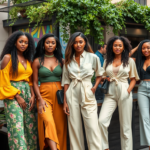When it comes to black tie events, the question on everyone’s mind is, “”Do I have to wear black?”” The simple answer is yes, for men, the tradition dictates that a black dinner jacket is typically expected, which naturally raises the query: what does black tie mean for men? Well, for men, black tie attire signifies a high standard of dress code that is both refined and unmistakably linked to evening formality. This article delves into the history, significance, and contemporary interpretation of this esteemed dress code.
Decoding the Black Tie Dress Code
Understanding the black tie dress code for men can seem daunting at first, but familiarizing oneself with its elements can help guests navigate the expectations with confidence. The black tie dress code for men requires a few key pieces that compose a classic, polished look meant for formal occasions.
Men’s Traditional Black Tie Attire
Men often wonder, “”Does black tie mean black suit?”” The answer is that the black tie dress code for men does involve a black suit, specifically a tuxedo or dinner jacket ensemble that is the cornerstone of men’s formal attire. Here’s a breakdown of the essential components of men’s traditional black tie:
- A black dinner jacket or tuxedo with silk lapels is the norm, adhering to the foundational question: what does black tie mean for men?
- Black formal trousers with a silk stripe down the leg complement the jacket.
- A white dress shirt with a turned-down collar provides a sharp contrast to the dark jacket.
- A black silk bow tie is the quintessential neckwear for such events.
- A black cummerbund or low-cut waistcoat is an element of tradition and style in the black tie ensemble.
- Black patent leather shoes are necessary to round off the outfit with the expected finish.
Women’s Elegant Black Tie Options
For women attending these events, the pressing question may be, “”Does black tie mean long dress?”” Generally, the answer is yes, as black tie events usually call for floor-length evening gowns or sophisticated, formal cocktail dresses. This allows for a display of elegance and an opportunity for personal expression within the formal parameters:
- The long dress, either in traditional black or other formal tones, is the centerpiece of women’s black tie attire.
- Elegant jewelry such as pearls or diamonds can be chosen to tastefully accent the dress.
- Accessories like a refined clutch and evening shawl or wrap may complete the ensemble.
- Refined heels, carefully selected, ensure the overall appearance is impeccable and event-appropriate.

The Significance of Wearing Black
The Tradition of Black in Formal Events
The color black has long been associated with formality and elegance, often seen as a symbol of sophistication and a sartorial representation of seriousness. Initially, black tie was equivalent to “”semi-formal,”” in contrast to the “”full dress”” or “”white tie”” dress code. The simple yet powerful color palette of a black tie event ensures a unified look that promotes a sense of occasion and prestige.
Is Black Mandatory?
Though the dress code is traditionally strict, there’s room for interpretation that reflects evolving fashion norms. For men, black tie typically means a black suit or tuxedo, but women have more latitude to incorporate other dark colors that maintain an equivalent level of formality. For instance, deep navy or dark jewel tones can still align well with the black tie dress code for women, responding to the question, does black tie mean long dress, with a touch of flexibility.
Dressing for a Black Tie Event in Style
Dressing up for a black tie event means more than selecting the right attire; it’s a meticulous process that involves style, comfort, and an understanding of tradition. Here are some tips for choosing the perfect black tie outfit:
- Ensure the fit is immaculate; a well-tailored suit or gown always makes the most elegant statement.
- Pay attention to fabrics; premium materials like silk, satin, and velvet are fundamentals for a luxurious appearance.
Consider the table below for a quick reference to men’s and women’s black tie essentials:
| Men’s Black Tie Essentials | Women’s Black Tie Essentials |
|---|---|
| Black dinner jacket/tuxedo | Evening gown/cocktail dress |
| White dress shirt | Elegant clutch |
| Black bow tie | Minimalist jewelry |
| Patent leather shoes | Heeled shoes |
| Cummerbund or waistcoat | Evening shawl or wrap (optional) |
In the following segment, we will look at how to craftily avoid common fashion faux pas and seamlessly incorporate personal style into your black tie ensemble while maintaining the requisite level of formality.

Avoiding Common Fashion Faux Pas
When it comes to black tie attire, there are several common mistakes that can detract from the overall elegance of your look. Here’s a list of pitfalls to avoid:
- Over-embellishment: While accessorizing is encouraged, overload can be a distraction. Select tasteful, subtle pieces that add to your outfit without overwhelming it.
- Ignoring fit: An ill-fitting garment, whether it’s too loose or too tight, can ruin the sophisticated look one is aiming for. It’s worth investing in tailoring to ensure a perfect fit.
In addition to these points, one should refrain from casual footwear or too informal hairstyles, as these can undercut the formality of your attire. Also, while mixing and matching can exhibit creativity, for black tie, it’s prudent to stick to tradition.
Incorporating Personal Style into Black Tie
While the black tie dress code does imply certain standards, there is room for one’s personal style to shine through. Here’s how to marry individuality with formality:
- Play with textures and materials within the monochromatic scheme to add a sense of individuality while staying faithful to the black tie theme.
- Use accessories such as cufflinks, ties, or unique clutch bags to bring personality into the mix without breaking away from the dress code.
The key is balance—maintaining the black tie spirit while expressing one’s unique fashion sense. Personal style shouldn’t overshadow the essence of the event’s attire but rather elevate it.
The Do’s and Don’ts of Accessorizing
Accessories can make or break a black tie outfit. Here are some guidelines:
- Do choose accessories that complement but don’t compete with your attire. A classic wristwatch or a pocket square can add a touch of class.
- Don’t let accessories become distractions. They should not be loud or controversial in design.
Remember, accessories are the final touches that polish your overall appearance, so be thoughtful in your selections.

Conclusion
Successfully navigating a black tie event is about respect for tradition while ingeniously incorporating one’s personal flair. Understanding the ‘why’ behind these rules can help one better adhere to them, and doing so with grace exemplifies one’s consideration for the event’s prestige and fellow attendees. Embrace the elegance of the black tie dress code, and let the sophistication of the tradition enhance your natural poise and confidence.
FAQs
Can a woman wear a suit to a black tie event?
Yes, a woman can wear a suit to a black tie event as long as it’s elegant, well-tailored, and complements the formality of the occasion.
Are there color restrictions for men’s tuxedos at black tie events?
While traditional black tie attire involves black tuxedos, midnight blue is also acceptable and can appear even darker than black under artificial light.
How do I know if my event is black tie?
The invitation should specify the dress code. If it reads ‘black tie’, then men should wear a tuxedo, and women should wear a formal gown or sophisticated cocktail dress.
Can I opt for a creative black tie?
Creative black tie allows for more personal expression through bold accessories or slight variations in attire while maintaining the formality of traditional black tie.
Is it acceptable to rent a tuxedo for a black tie event?
Absolutely. Renting a tuxedo is a practical option for those who may not frequently attend black tie events and want to ensure a proper, contemporary fit.





